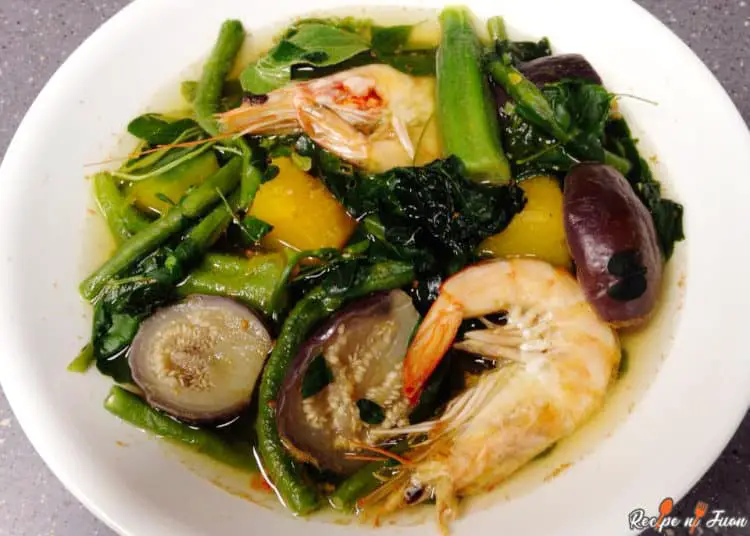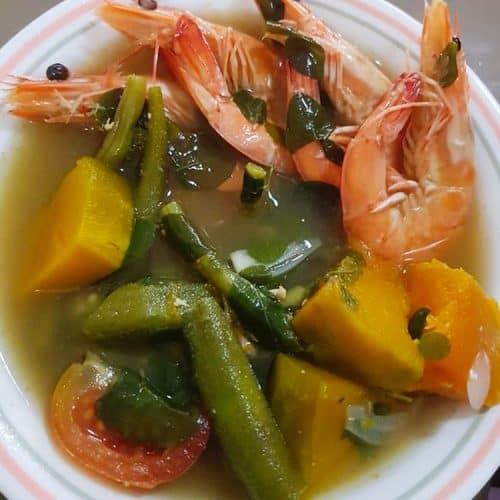Laswa recipe: A native Ilonggo dish full of veggies!
Laswa is a native Ilonggo recipe made entirely of vegetables with a medium-sized dish as its “sahog”. It’s kind of like a vegetable soup, only thicker.
Zooming into the laswa recipe, it boasts a variety of vegetables in its list, which includes squash, saluyot, okra, eggplant, string beans, and patola.
The main taste of this recipe centers around how these vegetables mix their flavors to have a unified, earthy, and humble taste.
Another main ingredient (shrimp) is supposed to be left as it is, neither deveined nor shelled, so as to also give its sea-fresh flavor to the entire dish and also to retain its individual taste.
This laswa recipe with seafood is the perfect healthy food for your family. It’s not only delicious, but also nutritious because of all the vegetables used in making it.
So the next time you’re looking for a veggie dish with lots of yummy flavors, this is it!



Check out our new cookbook
Bitemybun's family recipes with complete meal planner and recipe guide.
Try it out for free with Kindle Unlimited:
Read for freeIn this post we'll cover:
Laswa recipe: A native Ilonggo dish
Ingredients
- 250 g fresh shrimp cleaned with heads and shells intact
- 250 g squash diced
- 2 pcs eggplant cut into wedges
- 10 pcs okra cut into wedges
- 5 pcs string beans cut into 2-inch pieces
- ½ medium-sized patola sliced
- 1 bunch saluyot
- 8 cups water
- Salt to taste
Instructions
- Bring water to a boil and add fresh shrimp.
- When the shrimp turn pinkish, add squash and okra, and simmer for 2-5 minutes or until squash is slightly tender.
- Add string beans and eggplant, and simmer for 2 minutes.
- Add patola and simmer for 1 minute. Season with salt to taste.
- Turn off heat and add the saluyot so it won’t get overcooked.
- Serve immediately while hot.
Notes
Nutrition
Take a look at this version of laswa that YouTuber Panlasang Pinoy makes that has fish:
Cooking tips
The laswa recipe is very easy to follow since you can just either put all of the sliced ingredients (except for the shrimp) in the pot and pour the water in, or you can do it in reverse.
Also, as you’re using plain water for the broth of this laswa recipe, putting in more okra or more saluyot will add more body and texture to the dish.
You can add salt at the beginning, but it’s better to wait until all the vegetables are cooked before adding it so you can taste and adjust accordingly.
When it comes to veggies, I’ve already listed the best ones to use. But frankly, whatever green produce is available at the moment is perfect for laswa!
Substitutions & variations
Laswa is similar to dinengdeng of the Ilocanos and bulanglang of the Batangueños.
However, the laswa recipe differentiates itself from dinengdeng, as the former uses salt as its seasoning, whereas dinengdeng uses bagoong isda. Laswa is also different from bulanglang in that laswa uses plain water for its broth while bulanglang uses rice wash.
It could be said though, that these 3 are essentially all vegetable stews, but only with regional variations.
Since the laswa ingredients aren’t set in stone, when it comes to vegetables, you can use anything you have on hand. Green beans, ampalaya, kalabasa, and malunggay are all great substitutions for the veggies listed in the recipe.
And when it comes to shrimp, the native Ilonggo recipe calls for fresh shrimp. But you can definitely use frozen shrimp or even omit it altogether to make this a vegetarian dish.
The shrimp can be cleaned in case you’re using fresh shrimp. But I’d recommend keeping the heads and shells on for extra flavor.
If you want a bit more protein in your laswa, you can also add some pork or chicken. Grilled fish or fried fish can also be added, although that turns it into another dish altogether, which is sinigang na isda.
The laswa recipe is very versatile and forgiving, so feel free to experiment with it!
Some people might add some coconut milk to make the laswa more creamy. But I personally don’t think it’s necessary.
Also, if you feel the seafood taste isn’t strong enough, you can add some fish paste or fish sauce to your laswa.
And lastly, if you want a bit of a kick, you can add some chilis to the dish, which will make it even more delicious.

How to serve and eat
Laswa is best served hot and fresh. It can either be eaten as is or with some steamed white rice on the side.
Most Filipinos like to serve a simple veggie dish like laswa with some fried fish on the side. It can turn this into a complete meal.
If you want to go the extra mile, you can grate some fresh ginger into the soup when serving.
Laswa also pairs well with some pickled vegetables on the side.
How to store
If you have some leftover laswa, you can store it in the fridge for up to 3 days.
You can also freeze laswa for up to 2 months. When you’re ready to eat it, just thaw it in the fridge overnight and reheat.
I don’t really like freezing this dish because the vegetables can get quite mushy when reheated.
When reheating, make sure to add a little bit of water to the soup so it doesn’t dry out.
Similar dishes
If you like laswa, then you might also like these other Filipino dishes:
Sinigang
This is a soup dish that’s similar to laswa because it is also made with a variety of vegetables. The difference is that sinigang also has meat or seafood in it, so it’s more filling.
Paksiw
Paksiw is another Filipino soup dish that’s similar to laswa. The difference is that paksiw is usually made with fish or pork, and the soup is more vinegary.
Dinengdeng
As mentioned earlier, dinengdeng is similar to laswa because it’s also a vegetable soup. The difference is that dinengdeng is from the Ilocos region and has fewer vegetables.
Bulanglang
Bulanglang is another Filipino soup dish that’s similar to laswa. The difference is that bulanglang is usually made with papaya and squash.

Make this easy Filipino soup dish
In conclusion, laswa is a delicious and healthy Filipino soup dish that’s perfect for any occasion.
It’s easy to make and is versatile since you can utilize a variety of vegetables. You can also add meat or seafood to make it more filling.
When serving, you can pair it with rice or some fried fish.
Even if you’re a complete beginner in the kitchen, there’s no way you can’t make this Ilonggo dish since it’s super simple!
If you’re interested in learning more about laswa, then check out this article.
Check out our new cookbook
Bitemybun's family recipes with complete meal planner and recipe guide.
Try it out for free with Kindle Unlimited:
Read for freeJoost Nusselder, the founder of Bite My Bun is a content marketer, dad and loves trying out new food with Japanese food at the heart of his passion, and together with his team he's been creating in-depth blog articles since 2016 to help loyal readers with recipes and cooking tips.
